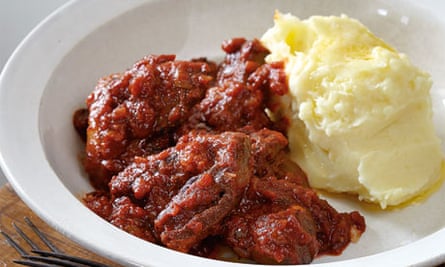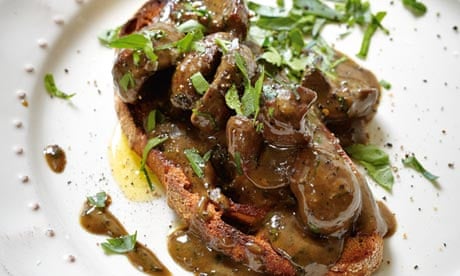I like to write about offal because I love to eat it, I want more people to enjoy it and, frankly, I still feel I need to remind you, once in a while, that it's out there. That meat-eaters ought to eat all the parts of an animal, not just the pretty bits, is obvious to me. But eating brains is a not a no-brainer for everyone. So let me rattle through a potted version of my Offal Manifesto.
First up, here's the moral imperative. If you eat meat, then the idea of eating liver or tongue shouldn't disturb you any more than tucking into a chop or a steak – it's all flesh and blood. What should make you feel queasy, I'd argue, is the preponderance of lean steaks and skinless, boneless chicken flesh in the meat aisles of most supermarkets – both representing only part of the whole animal. Where's the rest of it, and why aren't we eating it? If we kill an animal for meat, surely it's respectful to make the most of every scrap?
Killing for food is a momentous act, and we don't have to do it for our survival. If we undertake it lightly, cruelly or wastefully, we are shirking responsibility for the consequences of our appetites. If we make less of our livestock, we make less of ourselves.
Now here's the creative imperative. Call yourself a broad-minded, meat-loving, half-decent cook? Notice, then, that all those lean muscle cuts tend towards the same texture and taste – even if they are from different animals. OK, a lamb steak's a bit more lamby than a beef steak, but if variety of texture and flavour truly interests you, then you must turn to offal. The sweet-sharp tang of kidneys, the resistant density of heart, the mild creaminess of liver, the ready-made mousse of a lightly poached brain…in terms of sheer tongue-rolling interest, all these treats outflank a hunk of lean muscle every time.
If there's a "but" about offal, it's only this: it must be carefully sourced and, for the most part, really fresh. Offal is often lean and very delicate in its cell structure (liver and kidneys particularly) and harbours particular types of bacteria, related to the job it did inside the animal. This means it deteriorates much faster than muscle meat. Ideally, you want to get it within a few days of the animal's death. You can't always verify that – but fresh, raw offal will be firm, juicy and wet, without a strong smell.
As to provenance, this is of particular importance where glands and vital organs are concerned. I don't want to eat any meat from intensively farmed animals, but I particularly don't want to eat their liver, kidneys or sweetbreads. These are the parts of the body where unnecessary chemical input will make the most impact, where toxins will gather and where stress- or disease-related damage is more likely to occur. Offal from small producers whose animals are free-range, ideally organic, is by far your best bet.
It's quite easy now to get higher-welfare or organic offal by mail order, but I prefer to buy fresh offal from a trusted butcher or local farm, ideally from a counter where I can see it first.
When you get it home, cook your offal as soon as you can – the same day, as a rule. The distinctive flavours of these meats mean they can take some pretty punchy partners – aromatic herbs, piquant sauces, hot spices, onions and garlic, for instance. Get that mix right – good, fresh cuts, cooked simply but with attitude – and your offal experience will be satisfying on every level: ethical, gastronomic, visceral.
Devilled kidneys on toast
One of my all-time favourite kidney recipes, and one I often serve to the offal-dubious. It usually goes down a treat. Serves two.
A little sunflower or olive oil
4 lamb's kidneys, cut into quarters, with the whitish core trimmed out
1 small glass sherry
1 tbsp cider vinegar
1 tsp redcurrant jelly
A few good shakes of Worcestershire sauce
A good pinch of cayenne pepper
1 tbsp English mustard
Sea salt and freshly ground black pepper
1 tbsp double cream
A little chopped parsley, to garnish
Heat the oil in a small frying pan, add the kidneys and sizzle for just a minute to brown them, tossing them occasionally. Add the sherry, let it bubble for a moment, then add the vinegar. Add the redcurrant jelly and stir to dissolve, then the Worcestershire sauce, cayenne pepper, mustard and plenty of black pepper. Season with a pinch of salt, add the cream and bubble for another minute or two, shaking the pan occasionally, until the sauce is reduced and glossy. Taste for piquancy and add more cayenne or black pepper if you like. Serve on toast, with parsley scattered on top.
Poached tongue with white beans, garlic and parsley
Many butchers and even some supermarkets sell whole pickled (brined) uncooked ox tongues. They take a while to cook, but the process couldn't be easier. Depending on how salty they are – ask your butcher – they might need soaking in plenty of cold water before cooking. You can also make this with a fresh, unpickled ox tongue. Conversely, it will benefit from 24 hours in a simple brine (1.5kg salt to 5 litres water), before cooking.
2 tbsp extra-virgin olive oil, plus more to finish
2 cloves garlic, peeled and chopped
2 tins white beans (cannellini, say), drained and rinsed (or use pre-soaked and cooked dried beans)
2-3 tbsp roughly chopped flat-leaf parsley
For the tongue
1 pickled (or fresh) ox tongue, soaked (or brined) as necessary
2 bay leaves
1 carrot, roughly chunked
1 stick celery, roughly chunked
1 onion, peeled and quartered
Put the tongue in a large pan and cover with water. Add the bay leaves, carrot, celery and quartered onion. Bring to a gentle simmer, skim off any scum and cook for two and a half to three hours, until the tongue feels tender and the skin peels away easily.
Remove the tongue from the pan with tongs. When it's cool enough to handle, peel away the coarse skin and cut away any tough connective tissue on the underside. Keep warm.
Heat the oil in a large saucepan over a low heat. Add the garlic and let it cook very gently, without colouring, for a couple of minutes. Add the drained beans and stir them in the hot, garlicky oil for a couple of minutes, to heat through. Take off the heat, season well and stir through the parsley.
Serve the warm tongue in thick slices with a pile of garlicky beans on the side, trickled with a little more olive oil.
Paprikash of hearts and livers

Pungent, smoky paprika is a wonderful partner to the strong, iron-tinged flavours of offal. Serves four.
2 lamb or pigs' hearts
500g lamb or pigs' liver
2 tbsp olive, rapeseed or sunflower oil (or lard)
1kg onions, peeled and finely chopped
1 tbsp sweet paprika
1 tbsp smoked paprika (or Spanish pimentón)
2 tsp hot paprika
200ml tomato passata
Sea salt and freshly ground black pepper
Cut the hearts in half lengthways and trim out the coarse ventricles. Rinse the hearts in cold water, and pat dry. Trim any coarse sinews off the liver and cut it into four pieces.
Heat a tablespoon of oil in a heavy casserole, add the onions and cook gently, stirring occasionally, until soft and translucent. Add all the paprika, stir in well and cook for a couple of minutes.
Heat the rest of the oil in a separate pan and brown all the offal pieces in it, turning occasionally so they colour all over. Add the offal to the onion pot, together with the passata and a small glass of water. Bring to a very gentle simmer and cover. Cook over the lowest possible heat or in a very low oven (120C/250C/gas mark ½) for at least two hours, until the meat is very tender. Check occasionally, turning and adding a little water if it looks dry.
When the meat is cooked, check the consistency of the sauce: it should be thick, rich and pulpy. If need be, cook it for a few more minutes. Adjust the seasoning as necessary. You could finish the dish by stirring in a spoonful of soured cream or, as I prefer to do, just take soured cream to the table to serve with it. Accompany with mash.

Comments (…)
Sign in or create your Guardian account to join the discussion